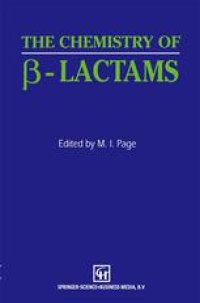
Ebook: The Chemistry of β-Lactams
- Tags: Organic Chemistry, Biochemistry general
- Year: 1992
- Publisher: Springer Netherlands
- Edition: 1
- Language: English
- pdf
It is over sixty years since Alexander Fleming observed antibiosis between a Penicillium mould and bacterial cultures and gave the name penicillin to the active principle. Although it was proposed in 1943 that penicillin (1) contained a tJ-Iactam ring, this was not generally accepted until an X-ray crystallographic determination of the structure had been completed. RCONH )=r)< o '" (I) 'C0 H 2 Penicillin was the first naturally occurring antibiotic to be characterised and used in clinical medicine. It is now seen as the progenitor of the tJ-Iactam family of antibiotics, which are characterised by the possession of the four membered tJ-Iactam ring. Chapters in this book will describe how current research has demonstrated that other lactam structures may also show antibacterial activity. Penicillins and cephalosporins (2), the second member of the tJ-Iactam antibiotic family, were both originally discovered in fungi but later detected in streptomycetes. Until 1970 penicillins and cephalosporins were the only examples of naturally occurring tJ-Iactam antibiotics. The discovery of 7-a-methoxy cephalosporins (3) from Streptomyces in 1971 stimulated the search for novel tJ-Iactam antibiotics from microbes, both by using sensitive new screening procedures, and by laboratory synthesis.
This book provides an authoritative review of developments in the chemistry of Beta-lactams: in particular the synthesis, reactivity and mechanisms of reaction, including novel Beta-lactam structures and non-Beta-lactam analogues.
This book provides an authoritative review of developments in the chemistry of Beta-lactams: in particular the synthesis, reactivity and mechanisms of reaction, including novel Beta-lactam structures and non-Beta-lactam analogues.
Content:
Front Matter....Pages i-xix
1 The biosynthesis of ?-lactams....Pages 1-78
Structure-activity relationships: chemical....Pages 79-100
Structure-activity relationships: biological....Pages 101-128
The mechanisms of reactions of ?-lactams....Pages 129-147
Mode of action: interaction with the penicillin binding proteins....Pages 148-197
?-Lactamase: mechanism of action....Pages 198-228
?-Lactamase: inhibition....Pages 229-271
Novel ?-lactam structures — the carbacephems....Pages 272-305
Non-?-lactam mimics of ?-lactam antibiotics....Pages 306-324
Classical ?-lactam structures....Pages 325-347
Back Matter....Pages 349-351
This book provides an authoritative review of developments in the chemistry of Beta-lactams: in particular the synthesis, reactivity and mechanisms of reaction, including novel Beta-lactam structures and non-Beta-lactam analogues.
Content:
Front Matter....Pages i-xix
1 The biosynthesis of ?-lactams....Pages 1-78
Structure-activity relationships: chemical....Pages 79-100
Structure-activity relationships: biological....Pages 101-128
The mechanisms of reactions of ?-lactams....Pages 129-147
Mode of action: interaction with the penicillin binding proteins....Pages 148-197
?-Lactamase: mechanism of action....Pages 198-228
?-Lactamase: inhibition....Pages 229-271
Novel ?-lactam structures — the carbacephems....Pages 272-305
Non-?-lactam mimics of ?-lactam antibiotics....Pages 306-324
Classical ?-lactam structures....Pages 325-347
Back Matter....Pages 349-351
....